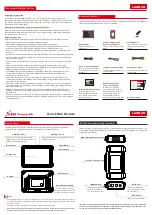
ix
────────────────────────────────────────────────────
Notes on Use
────────────────────────────────────────────────────
NOTE
・
All options for this unit are factory-fitted, but it is also possible to add
options at a later date after purchase. In this case, however, it is necessary
for the unit to be returned to
HIOKI
headquarters.
・
With the appropriate combination of direct connection input units, this unit
can function as either an AC power meter or dual AC/DC power meter.
When used together with clamp input units, depending on whether the clamp
sensor used is for AC or DC, this unit can function as either an AC power
meter or dual AC/DC power meter. When used as an AC power meter, it is
not possible to measure a DC component superimposed on the AC signal
(half-wave rectification, or full-wave rectification upper and lower excluded
waveform).
・
Note that limits are specified for the range in which voltage and current level
accuracies are guaranteed.
・
In order to assure accurate measurements, allow this unit to warm up for at
least 1 hour before using it.
・
This power meter uses the calculations indicated in the specifications in
order to determine apparent power (
S
), power factor (
λ
), and reactive power
(
Q
) on the basis of the measured voltage (
U
), current (
I
), and active power
(
P
). The values displayed by this power meter may differ from those
produced by other testers that are based on different principles of operation
or testers that use different calculations.
・
Display of a polarity symbol (-) together with reactive power (
Q
), power
factor (
λ
) or phase angle (
φ
) occurs only when TYPE1 is selected as the
calculation type, and indicates that current is delayed with respect to
voltage. For reasons related to circuit design, the polarity symbol is
displayed even when input is "0".
・
Due to measuring error or a disproportionate load, the effective power may
exceed the apparent power, resulting in a power factor of 1 or more. In such
a case, this system is designed to make the apparent power equal to the
effective power.
・
There are two sorts of measurement: using analog calculation by the input
unit or by digital calculation using the harmonic analysis/flicker
measurement function, and since these have entirely different principles of
measurement, frequency range, and accuracy, and as a result the final
measured values may be different.
・
Accurate measurement may be impossible in locations subject to strong
external magnetic fields, such as transformers and high-current conductors,
or in locations subject to strong external electric fields, such as radio
transmission equipment.
・
For the current measurement of the 9600 AC/DC DIRECT INPUT UNIT, the
DC-CT (current transformer) method is used, so after measuring a large
current, there may be a very slight residual offset signal. The offset signal
produces the largest error effect in the minimum ranges; in this case, shut
off the current input, and carry out degaussing (DMAG).
・
The 9600, 9601, and 9602 active power measurement units operate with an
auto-zero circuit at 2.442 kHz. For this reason, an input signal with a
frequency of 2.442 kHz will result in a periodically fluctuating display
indication.
Summary of Contents for Power HiTester 3193
Page 2: ......
Page 50: ...32 3 9 Operations During Power Failure ...
Page 76: ...58 4 13 Degaussing ...
Page 80: ...62 5 2 Setting the Frequency Range fa ...
Page 108: ...90 9 3 Internal Circuit for the External Control and Timing ...
Page 112: ...94 10 3 Output Rate ...
Page 250: ...232 13 9 Error and Overflow Displays ...
Page 278: ...260 17 5 Internal Block Diagram ...
Page 284: ...266 19 2 Installation Procedures For JIS standard For EIA standard External Dimensions ...
Page 300: ...282 20 4 Internal Block Diagram of the 3193 ...
Page 306: ...INDEX 4 Index ...
Page 307: ......
Page 308: ......
Page 309: ......
Page 310: ......
















































